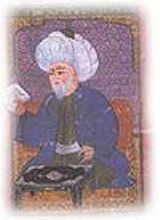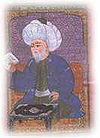
Prose of the Ottoman Empire
Encyclopedia

Non-fiction
Non-fiction is the form of any narrative, account, or other communicative work whose assertions and descriptions are understood to be fact...
in nature; and later Ottoman prose, which extended from the mid-19th century Tanzimat period
Tanzimat
The Tanzimât , meaning reorganization of the Ottoman Empire, was a period of reformation that began in 1839 and ended with the First Constitutional Era in 1876. The Tanzimât reform era was characterized by various attempts to modernize the Ottoman Empire, to secure its territorial integrity against...
of reform to the final fall of the Ottoman Empire
Ottoman Empire
The Ottoman EmpireIt was usually referred to as the "Ottoman Empire", the "Turkish Empire", the "Ottoman Caliphate" or more commonly "Turkey" by its contemporaries...
in 1922, and in which prose fiction
Fiction
Fiction is the form of any narrative or informative work that deals, in part or in whole, with information or events that are not factual, but rather, imaginary—that is, invented by the author. Although fiction describes a major branch of literary work, it may also refer to theatrical,...
was first introduced.
Early Ottoman Prose
Early Ottoman prose, before the 19th century CE, never developed to the extent that the contemporary Divan poetry did. A large part of the reason for this was that much prose of the time was expected to adhere to the rules of seci, or rhymed proseRhymed prose
Rhymed prose is a literary form and literary genre, written in unmetrical rhymes. This form has been known in many different cultures. In some cases the rhymed prose is a distinctive, well-defined style of writing...
, a type of writing descended from Arabic literature (saj'
Saj'
Saj‘, is a form of rhymed prose in Arabic literature. It is named so because of its evenness or monotony, or from a fancied resemblance between its rhythm and the cooing of a dove. It is a highly artificial style of prose, characterized by a kind of rhythm as well as rhyme...
) and which prescribed that between each adjective and noun in a sentence, there must be a rhyme
Rhyme
A rhyme is a repetition of similar sounds in two or more words and is most often used in poetry and songs. The word "rhyme" may also refer to a short poem, such as a rhyming couplet or other brief rhyming poem such as nursery rhymes.-Etymology:...
.
Nevertheless, there was a long tradition of prose in the Ottoman Empire. This tradition was, for centuries, exclusively nonfictional
Non-fiction
Non-fiction is the form of any narrative, account, or other communicative work whose assertions and descriptions are understood to be fact...
in nature—the fiction
Fiction
Fiction is the form of any narrative or informative work that deals, in part or in whole, with information or events that are not factual, but rather, imaginary—that is, invented by the author. Although fiction describes a major branch of literary work, it may also refer to theatrical,...
tradition was limited to narrative poetry. A number of such nonfictional prose genres developed:
- the seyahâtnâme, or travelogueTravel literatureTravel literature is travel writing of literary value. Travel literature typically records the experiences of an author touring a place for the pleasure of travel. An individual work is sometimes called a travelogue or itinerary. Travel literature may be cross-cultural or transnational in focus, or...
, of which the outstanding example is the 17th-century SeyahâtnâmeSeyahatnameSeyâhatnâme is a Persian term, also used in Ottoman Turkish, which means "book of travels", denoting a literary form and tradition whose examples can be found throughout centuries in the Middle Ages around the Islamic world, starting with the Arab travellers of the Umayyad period.An outstanding...
of Evliya ÇelebiEvliya ÇelebiEvliya Çelebi was an Ottoman traveler who journeyed through the territory of the Ottoman Empire and neighboring lands over a period of forty years.- Life :... - the sefâretnâme, a related genre that is a sort of travelogue of the journeys and experiences of an Ottoman ambassadorAmbassadorAn ambassador is the highest ranking diplomat who represents a nation and is usually accredited to a foreign sovereign or government, or to an international organization....
, and which is best exemplified by the 1718–1720 Paris Sefâretnâmesi of Yirmisekiz Mehmet Çelebi Efendi, ambassador to the court of Louis XV of FranceLouis XV of FranceLouis XV was a Bourbon monarch who ruled as King of France and of Navarre from 1 September 1715 until his death. He succeeded his great-grandfather at the age of five, his first cousin Philippe II, Duke of Orléans, served as Regent of the kingdom until Louis's majority in 1723... - the siyâsetnâme, a kind of political treatise describing the functionings of state and offering advice for rulers, an early Seljuk example of which is the 11th-century SiyāsatnāmaSiyasatnamaSiyāsatnāma , also known as Siyar al-muluk , is the most famous work by Nizam al-Mulk, the founder of Nizamiyyah schools in medieval Persia and vizier to the Seljuq sultans Alp Arslan and Malik Shah...
, written in Persian by Nizam al-MulkNizam al-MulkAbu Ali al-Hasan al-Tusi Nizam al-Mulk, better known as Khwaja Nizam al-Mulk Tusi ; born in 1018 – 14 October 1092) was a Persian scholar and vizier of the Seljuq Empire...
, vizierVizierA vizier or in Arabic script ; ; sometimes spelled vazir, vizir, vasir, wazir, vesir, or vezir) is a high-ranking political advisor or minister in a Muslim government....
to the Seljuk rulers Alp ArslanAlp ArslanAlp Arslan was the third sultan of the Seljuq dynasty and great-grandson of Seljuk, the eponymous founder of the dynasty...
and Malik Shah IMalik Shah IJalāl al-Dawlah Malik-shāh was born in 1055, succeeded Alp Arslan as the Seljuq Sultan in 1072, and reigned until his death in 1092.... - the tezkire, a collection of short biographiesBiographyA biography is a detailed description or account of someone's life. More than a list of basic facts , biography also portrays the subject's experience of those events...
of notable figures, some of the most notable of which were the 16th-century tezkiretü'ş-şuaras, or biographies of poets, by Latîfî and Aşık Çelebi - the münşeât, a collection of writings and letters similar to the Western tradition of belles-lettresBelles-lettresBelles-lettres or belles lettres is a term that is used to describe a category of writing. A writer of belles-lettres is a belletrist. However, the boundaries of that category vary in different usages....
- the münazara, a collection of debateDebateDebate or debating is a method of interactive and representational argument. Debate is a broader form of argument than logical argument, which only examines consistency from axiom, and factual argument, which only examines what is or isn't the case or rhetoric which is a technique of persuasion...
s of either a religious or a philosophical nature

